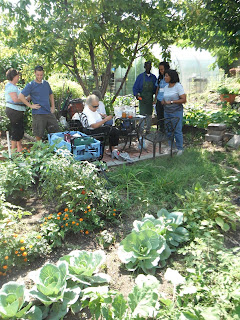I recently had the pleasure of attending the American Community Gardening Association’s 32nd Annual National Conference in New York City, along with four local colleagues who are involved with community gardens work. It’s a conference that travels to different locations each year to highlight the unique approaches that different cities are taking to promote and produce local, healthy food. Worthwhile, to say the least, it was an eye-opening trip that invigorated the passion for gardening and provided us with ideas and inspiration to take back to Crescent City.
The sprawling urban jungle of Manhattan might not be the image that comes to mind when you think about growing food and gardening; but throughout the boroughs of the city, groups like GrowNYC, Bronx Green-Up, and Green Guerillas are dedicating themselves to urban agriculture and the “greening” of their neighborhoods. From a couple neighbors building some raised beds near their apartments, to whole communities coming together to convert empty city blocks, every nook and cranny of New York City is dotted with gardens.
Right from the get-go, we were immersed in the spirit of healthy, local food with a street-side farmers market taking place right outside our registration. The five of us got the chance to wander the market, chat with the local producers and sample some of their products. Breanne Sorrells, Arcata Farmer’s Market manager and fellow traveler, wasted no time in finding the market manager to discuss the finer points of small-scale distribution in such a large and populated region. Though the Cities of Crescent and New York couldn’t be much more different, the farmer’s market vendors and managers deal with many of the same issues that we face in distributing local produce.
For the bulk of the conference, the five of us attended a series of lectures and workshops given by speakers who are involved with gardening at all different levels. It was enlightening to see the amount of interest, innovation, and passion that people put into community gardens and the ideas that some people have developed over decades of experience. “Uniting Neighborhoods,” a workshop on developing unique garden attractions, highlighted effective strategies for increasing community buy-in by focusing on children and families. “Cultivating Tradition” showed how to develop inter-generational ties to a garden by emphasizing the cultivation of culturally significant crops. I know I will personally benefit greatly from the workshop on Volunteer Management, and hopefully the benefit to the gardens will be visible to all. There was a wealth of experience to draw from, and all of us attendees will be working to implement our new knowledge into our own community.
Another large part of the conference consisted of tours through the boroughs to see first-hand the gardens that exist around every corner of New York. The near 200 conference attendees split into 13 tour groups to travel to all different corners of the city, from the North Bronx to Governor’s Island. I hopped on the bus with some 40 fellow attendees and tour guides from Bronx Green-Up, a local group dedicated to turning empty lots (or “gray space”) into thriving gardens. We headed to the Upper Bronx to see the gardens that exist in these ethnically diverse neighborhoods.
We traveled to seven different gardens and community farms, some of which have been thriving for decades, all of which provide healthy and culturally specific foods to areas that are in need. Virtually all of these gardens exist in food deserts, and each one of them was created from neighbors getting together and taking action to address their need for access to healthy food. In one Hispanic neighborhood, a community has created a garden that allows the people to grow culturally appropriate food in addition to producing more standard crops that they sell at weekly on-site markets to all the residents of the neighborhood. A place that was previously plagued by violence and drugs, not to mention being a food desert, now has an area that serves 150 youth through the local school, hosts a Puerto Rican Parade, and is providing fresh, healthy food while making money to maintain itself.
New York City is definitely a whole lot different than our own community; but when it comes to gardens, and people who feel passionate about food independence, there is a striking amount of similarity. While we’re relatively new to the idea of community gardening in Crescent City, we have the same spirit and drive that has led to such success in the urban environment of New York; and after attending the conference, I’m excited to see how our gardens develop and take shape into the future.





No comments:
Post a Comment